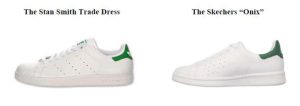It’s game, set, match for Adidas when it comes to the protectable trade dress in its iconic Stan Smith tennis shoe. In a dispute between Adidas and Skechers over the “Skecherizing” of the Stan Smith shoe, the District Court for the District of Oregon denied Skechers’ motion for summary judgment finding that Adidas could show it has protectable trade dress in its well-known shoe design because the design was recognizable to consumers and not functional. Adidas America Inc. et al. v. Skechers USA Inc., D. Or (August 3, 2017) (order granting in part and denying in part motion for summary judgment).
The Stan Smith shoe became famous in 1972 when its namesake, Stan Smith, won Wimbledon while wearing the shoes. Adidas sold approximately 40 million pairs of the Stan Smith shoe worldwide since then, and in 2013, Adidas removed the Stan Smith shoe from the market to increase demand. The Stan Smith shoe relaunched in 2014. In June 2014, Skechers, which is well known for “Skecherizing” other brands’ shoes, began designing its Onix shoe. Both shoes had a white upper, white sole and a green raised mustache-shaped colored heel patch, although the Onix shoe featured a patch of perforations in place of the Stan Smith shoe’s three rows of perforations.
To state a trade dress infringement claim under Section 43(a) of the Lanham Act “a plaintiff must meet three basic elements: (1) distinctiveness, (2) nonfunctionality, and (3) likelihood of confusion.” Kendall-Jackson Winery, Ltd. v. E. & J. Gallo Winery, 150 F.3d 1042, 1047 (9th Cir. 1998). Given the shoes’ similar appearances, Skechers did not dispute that there was a likelihood of confusion. Instead, the decision turned on whether the Stan Smith shoe design was distinctive and nonfunctional.
The Court considered the overall combination of trade dress elements and found that highly specific descriptions of the trade dress elements were sufficiently definite to warrant trade dress protection. Although evidence was introduced that occasional “special edition” shoes had different characteristics or details, the Court found that because Adidas did not claim those other designs under the Stan Smith trade dress in this case, it preserved its protection in the original design.
The Court also found that the Stan Smith shoes signified Adidas in the minds of consumers and had therefore acquired distinctiveness. The Court rejected Skechers’s argument that the overall design was generic and functional due to third-party use of certain design elements, noting that the key question in determining trade dress is the overall visual impression. Moreover, Skechers argued because it had done a survey of consumers which concluded that the shoe had not acquired distinctiveness— and that Adidas itself had performed no such survey—no genuine issue of material fact existed. But the Court had already ruled earlier in the proceedings that Adidas provided adequate evidence of acquired distinctiveness without a survey.
On the issue of functionality, the Court found that functional elements could become non-functional over time when viewed with the rest of the trade dress as a whole. Although the Stan Smith shoe was considered a performance tennis shoe at one point, the trade dress as a whole has become nonfunctional. The Court took note of prior cases in which Adidas’s trade dress had become nonfunctional despite evidence that it was once functional. Additionally, numerous alternative designs were available but Skechers chose to deliberately clone the Adidas shoe. Further, Adidas’s advertising focused on the shoe’s iconic style rather than any utilitarian advantages. On the whole, the Court found the Stan Smith shoe trade dress was not functional.
The decision also addressed Skechers’ use of Adidas’ Three-Stripe Mark on other shoes finding a genuine issue of material fact as to the likelihood of confusion and dilution of Adidas’ trade dress, among other issues.
For brand owners looking to enforce their rights in iconic brands, this decision provides the following takeaways:
- Clearly and concisely characterizing the protectable elements of trade dress is key, along with emphasizing the importance of reviewing the overall trade dress as a whole. Photos and diagrams are particularly helpful in reviewing the visual similarities.
- Consumer surveys may not be required if the brand owner shows other ample and convincing circumstantial evidence of acquired distinctiveness.
- Enforcement strategies should be consistent across cases related to a brand and courts may take judicial notice of strong evidence submitted in prior cases on the same brand.




 />i
/>i


